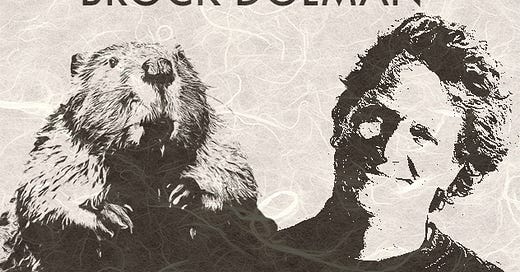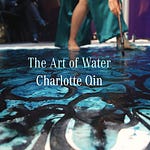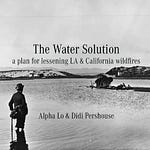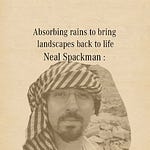When I first got into the water field, I keep hearing about this guy Brock Dolman, and the water work he was doing. So it with great pleasure that I now get the chance to interview him.
Brock began with a background in conservation biology, and then began thinking of himself as a conservation hydrologist. He helped found the Occidental Arts and Ecology Center (OAEC) in California, which hosts the Water Institute. He has done great work in bringing back the beaver, transitioning California to use more greywater, helping California with its water plans, and infusing many memorable phrases into the water field. His language use is lapidary, poetic, and creative. (You might want to rewind and relisten to many segments of this podcast because his language use allows for a high density of information.)
Here’s some highlights from the podcast that I transcribed below (with some little grammar tweaks)
On slow water [beginning 5:40min mark]
“Is it true you coined the phrase slow it sink it spread it?”
“Its true. I coined that phrase. My riff on it is “Slow it, spread it, sink it, store it, share it”. Its sort of of like Carlo Petrini’s slow food movement. I thought about this idea that I call the slow water movement. Because we’ve been having this fast water movement. We’ve been living in the drain age, where the dominant land use paradigm of North America for hundred of years since settler colonies is - kill the beaver, genocide the native people, drain the wetlands, ditch the land, and dehydrate it for settlement patterns. We have a drain age paradigm, where we have been draining, paving, piping, polluting, plundering, and making it go away as fast as possible and as dirty as possible.
We want to slow it, spread it, sink it, store it, and share it, and keep it around as clean and as long as possible…. The idea of the ‘slow it, spread it, sink it’ mantra comes out of my work for decades in storm water management and the clean water act at the Federal level, the Porter-Cologne act in California, the recognition of non-point source pollution being a really big deal. It comes out of low impact development, stormwater management, bioswales, porous pavement, roof water catchment and groundwater recharge, and those retrofitting land use to be a rehydrative sponge rather dehydrate system. Thats where I really synthesized nugget of the idea to slow it, sink it, spread it.
When I began working in urban stormwater management and low impact development, I brought the perceptual design method worldview of permaculture. Permaculture is a method of how to create regenerative and socially just systems that are based on natural patterns and processes. So when I was looking at stormwater management, and green infrastructure versus grey infrastructure, we used those tools - the principles of protracted observation, stacking functions, relative location and onsite resources, and planned redundancies. These are permaculture design principles. They apply to everything we do.
‘Slow it spread it sink it’ became a sticky meme that encapsulates an ethos, a deep level of work that the world is doing in the realms of stormwater management and low impact development.”
On beavers [20:50min]
“In the early 2000s nobody was really talking abut beavers in California, they were considered mostly nonnative and mostly a nuisance, and people just wanted to kill them. In 2012 the Occidental Arts and Ecology Center created the bring back the beaver campaign. We co-published a series of peer reviewed papers on the historic ecology of beaver in California - in the Sierra Nevada, the coastal zone, and in the Bay Area, asserting that they were more widely distributed than was thought, and that they were native to much of the state.
We articulated the benefits of the beaver. You’ve got a semi-aquatic mammal with big teeth and just enough smarts to slow it, sink it, spread it, store it, and share it. They are farmers that irrigate the riparian because they are vegetarian. They eat the bark of trees, cattails, willows, sedges and grasses. They are engineers that build dams. They are masons that seal the dams. They are farmers that irrigate food forests of riparian habitat. They recharge groundwater. And they make wetted areas things less flammable. Smoky the beaver is helping save smoky the bear.
Their wetlands are famous for sequestering carbon. The biodiversity in the wetlands is a bio filter that produces cleaner water with increased water quantity. The wetlands increase groundwater recharge, help with carbon sequestration, with flood attenuation, with fire resiliency, all the while making habitat for endangered species and increasing biodiversity. So why not bring back the beaver?
I am happy to say in California last summer, Governor Newsom put in a budget line to create brand new beaver restoration program. It has funding for five permanent staff. Those five staff and are working on beaver management plan. How can we coexist with beaver instead of killing them….. We are launching a historic campaign to bring back the beaver in California.
There are a lot of ranchers in Idaho, Wyoming, Eastern Oregon, Utah, and Nevada who said ‘Twenty, thirty years ago we killed beavers. Right now, if we didn’t have beavers, we would be out of business.” ….. The beavers rehydrate the valley bottoms, and the water laterally spreads out, so the pastures for the cattle are getting sub-surface irrigated. The ranchers have both more water for the cows to drink and more forage that is irrigated longer. So they have more cattle food…. We often say beavers and bovines are buddies.”
On biology and life [40:01min]
“The keystone processes of earth, fire, air, water and life is gaming all of those. Energy flows, matter cycles, and life webs. Life is creating the conditions for its own fecundity.”
“Equal inputs of carbon dioxide and water, are the dominant inputs to photosynthesis, so if you are not playing on the carbon cycle side and the water cycle side you are not creating conditions conducive to life, which is carbon based and mostly water. … Photosynthesis is the keystone coupler.”
On a Slow Water movement
Brock proposed the idea of a Slow Water movement in early 2000s and an article came out about it, which you can read here. (Erica Gies, author of “Water always wins”, has also been independently proposing this movement. Brock calls this convergent evolution.)
[58min] Brock talks about the template and training program they developed to help people organize and restore their watersheds. The project is called Basin of relations. You can find the guidebook here
[59:45min] Discussion of the slow water movement idea.
[1:02:26] On watersheds:
“I think of watersheds as living lifeboats from ridge to river, from summit to sea , from stem to stern. We have to rethink and retrofit these living lifeboats at every scale of land use, from forestry to rangeland to agriculture, to urbanization to surbanization, land use. How do we rethink and retrofit for rehydration? The tools in the toolbox is different at different size scales… The opportunity for a slow water movement is before us. If we are really looking at watersheds like lifeboats, the opportunity to organize together is like battening down the hatches for the coming storm of the present and future moment. These lifeboats are going to be tested. These lifeboats will fare better if we all pull together in the same direction, in a collaborative and convivial way, which is really about the community part of the relations in our basins, versus the competitive part where its about commodity and competition against.”
[1:03:39] I share my idea of slow water circles
[1:05:40] Discussion of slow water methods and slow water organizing in India, Zimbawe, Peru, Israel, Yemen, and the Arabian peninsula.
………………………………
A key role in getting greywater laws passed in California was when Elizabeth Dougherty, a citizen who regularly pestered and petitioned the government about greywater, connected the government and Stanford engineers with Brock Dolman, who taught them about greywater. You can listen to her story about this in a previous podcast in this newsletter.
…
This is a reader supported publication














Share this post